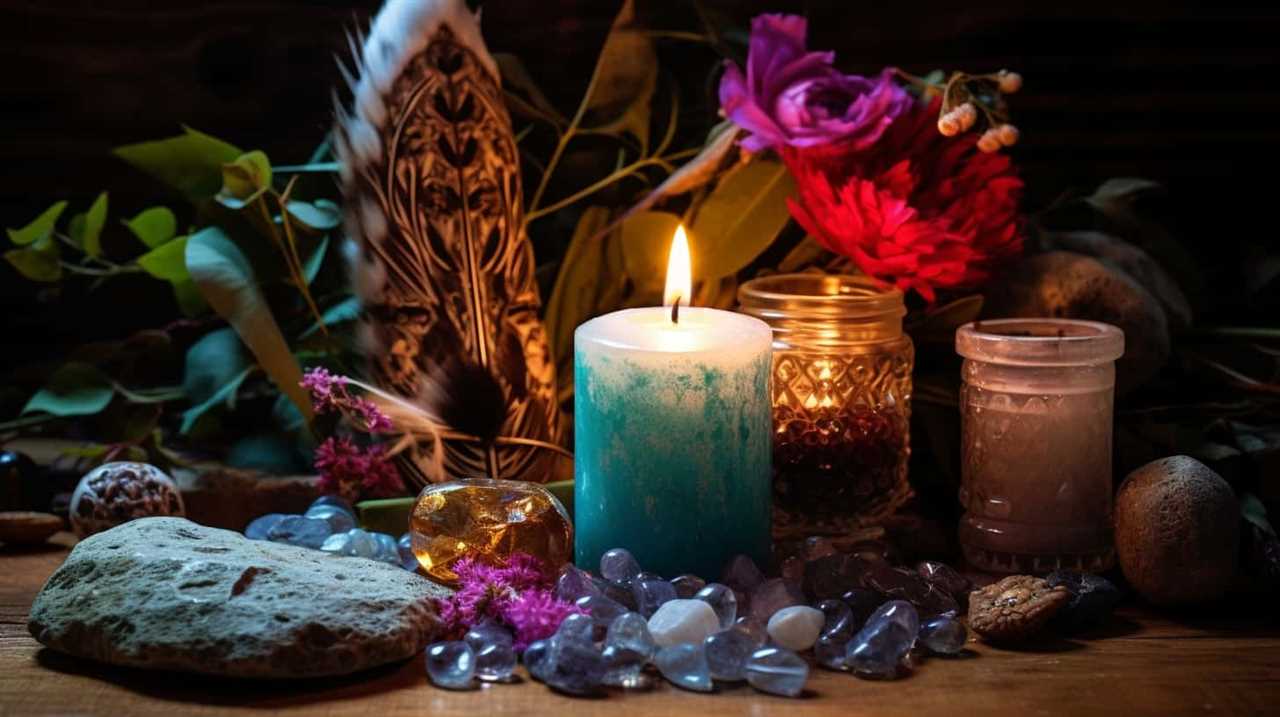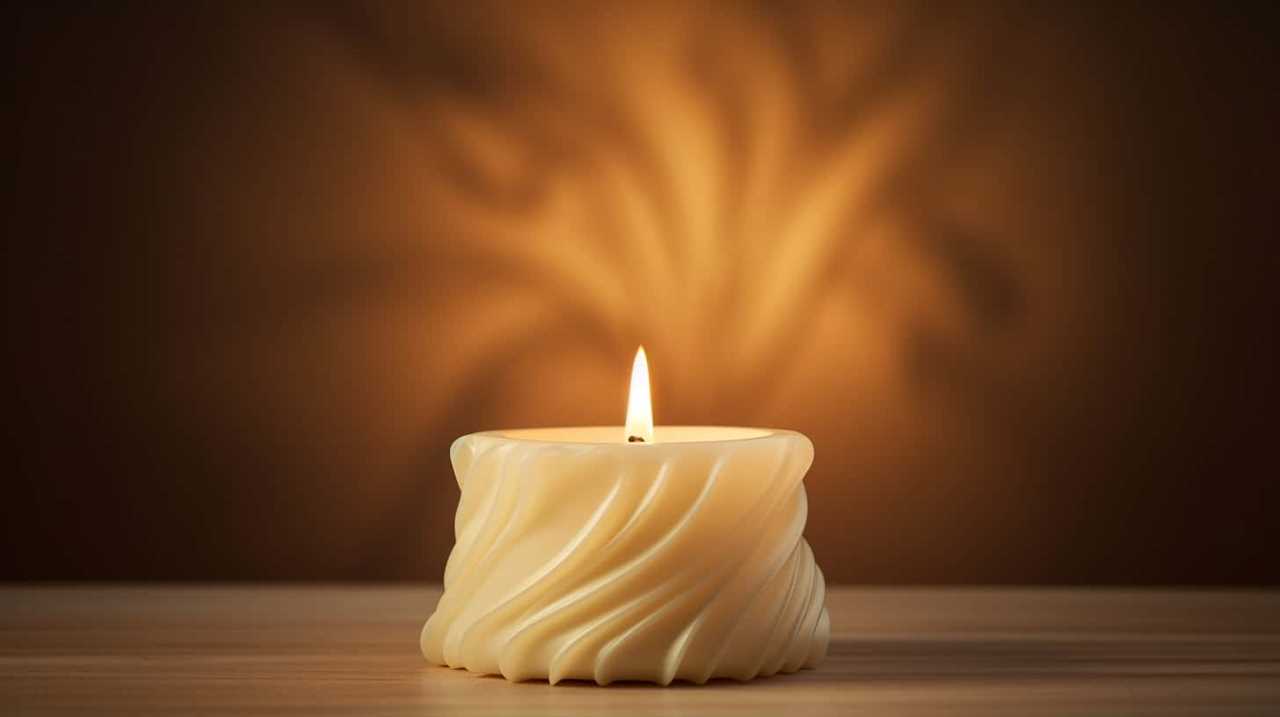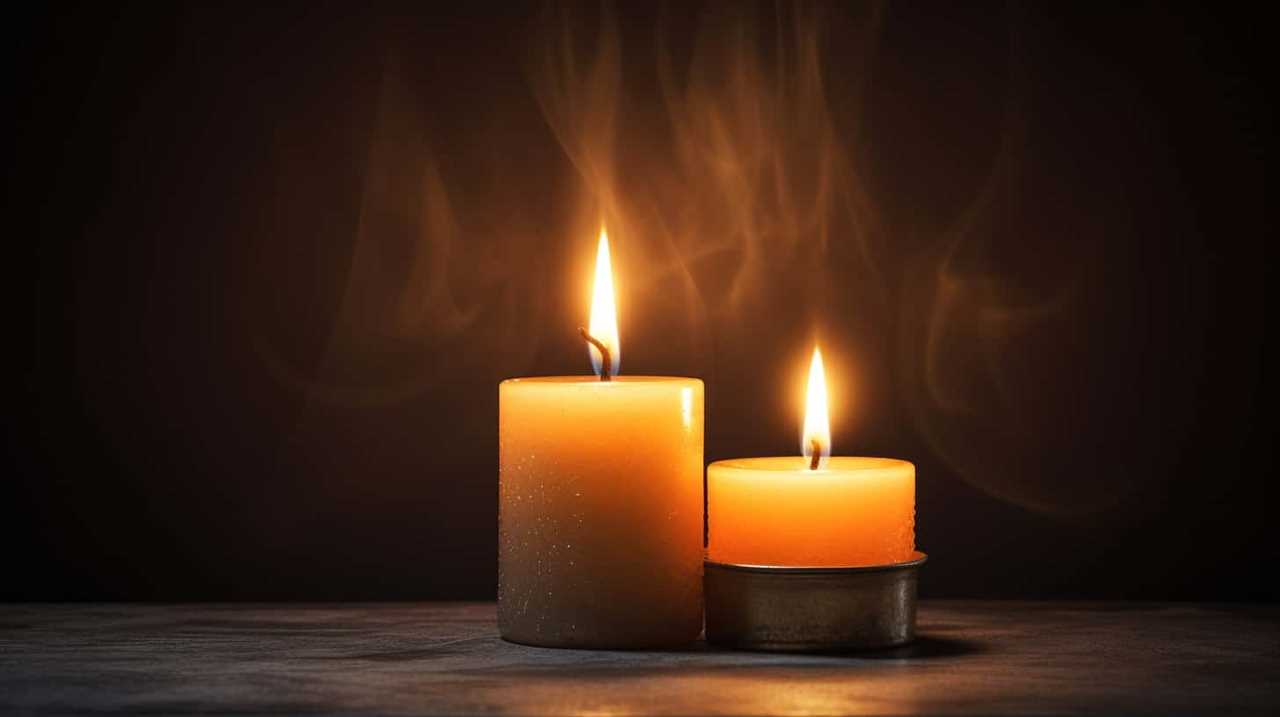What temperature should candle wax be at before pouring?
As candle-making enthusiasts, we understand the importance of getting the wax temperature just right. Achieving mastery in this craft requires a deep understanding of the factors that affect the melting point of wax, as well as knowing the optimal temperature range for different types of wax.
By using a thermometer, we can ensure accuracy and consistency in our candle-making process. Additionally, we must consider the temperature at which to incorporate fragrances and color the wax for optimal results.
Different candle styles may also require specific pouring techniques, which can be achieved by experimenting with wax temperature.

Join us as we explore the fascinating world of candle-making and uncover the secrets to achieving the perfect wax temperature for pouring.
Key Takeaways
- Optimal wax temperature ensures even melting and proper adhesion to the container.
- Different waxes have different melting points, requiring specific heating temperatures.
- Heating methods, such as direct heat or indirect heat, can influence the melting point.
- Environmental factors like room temperature and humidity can alter the melting point.
The Importance of Wax Temperature
The optimal wax temperature is crucial for successful candle pouring. Achieving the right temperature ensures that the wax melts evenly and adheres properly to the container, resulting in a high-quality candle.
To begin, it’s important to understand the melting point of the specific wax being used. Different waxes have different melting points, and it’s essential to heat the wax to the appropriate temperature to achieve a smooth and consistent pour. Temperature accuracy is key, as both overheating and underheating can lead to problems.
Overheating can cause the wax to become too thin and result in poor fragrance retention, while underheating can lead to uneven cooling and unsightly sinkholes. Therefore, it’s essential to use a reliable thermometer and monitor the wax temperature closely throughout the pouring process to ensure optimal results.
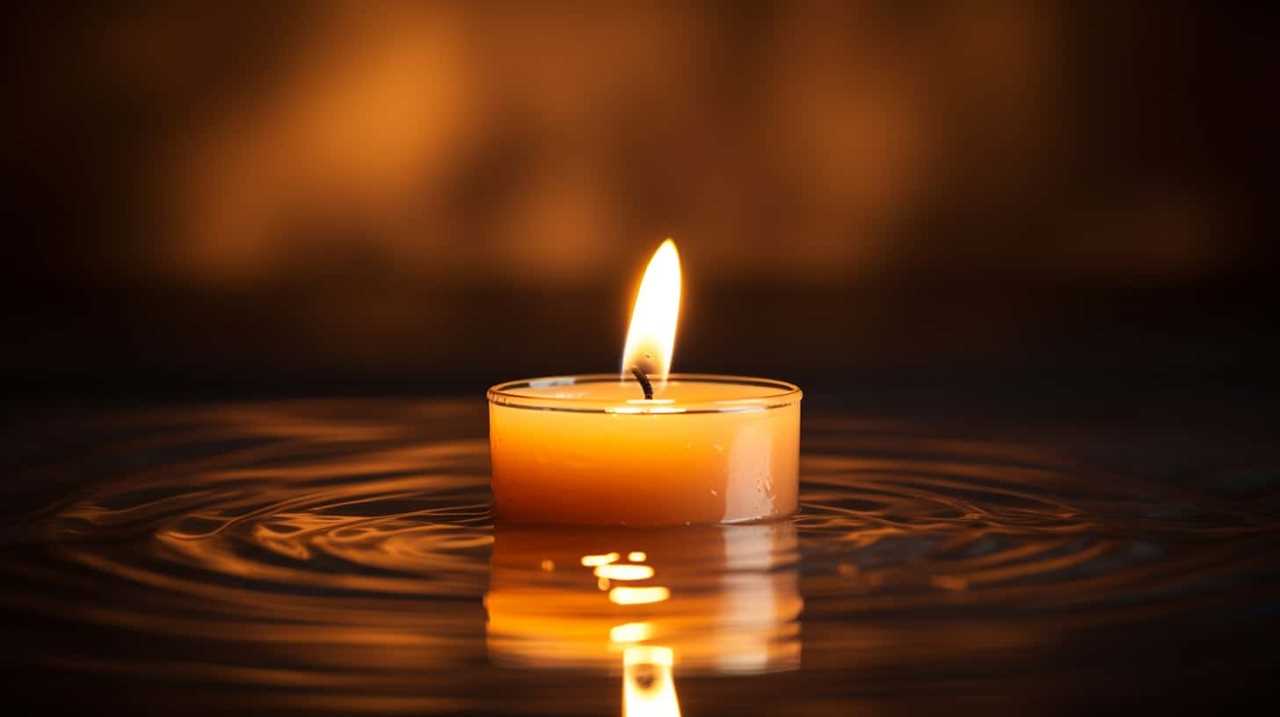
Factors Affecting Wax Melting Point
When considering the factors that affect the melting point of candle wax, three key points come to mind.
First, the composition of the wax itself plays a significant role in determining its melting point. Different types of wax, such as soy or beeswax, have different melting points due to variations in their chemical makeup.
Second, the method of heating the wax can also influence its melting point. Factors such as the heat source and the rate of heating can impact the overall temperature at which the wax melts.
Lastly, environmental factors like room temperature and humidity can affect the melting point of the wax, as they can alter the overall heat transfer process.
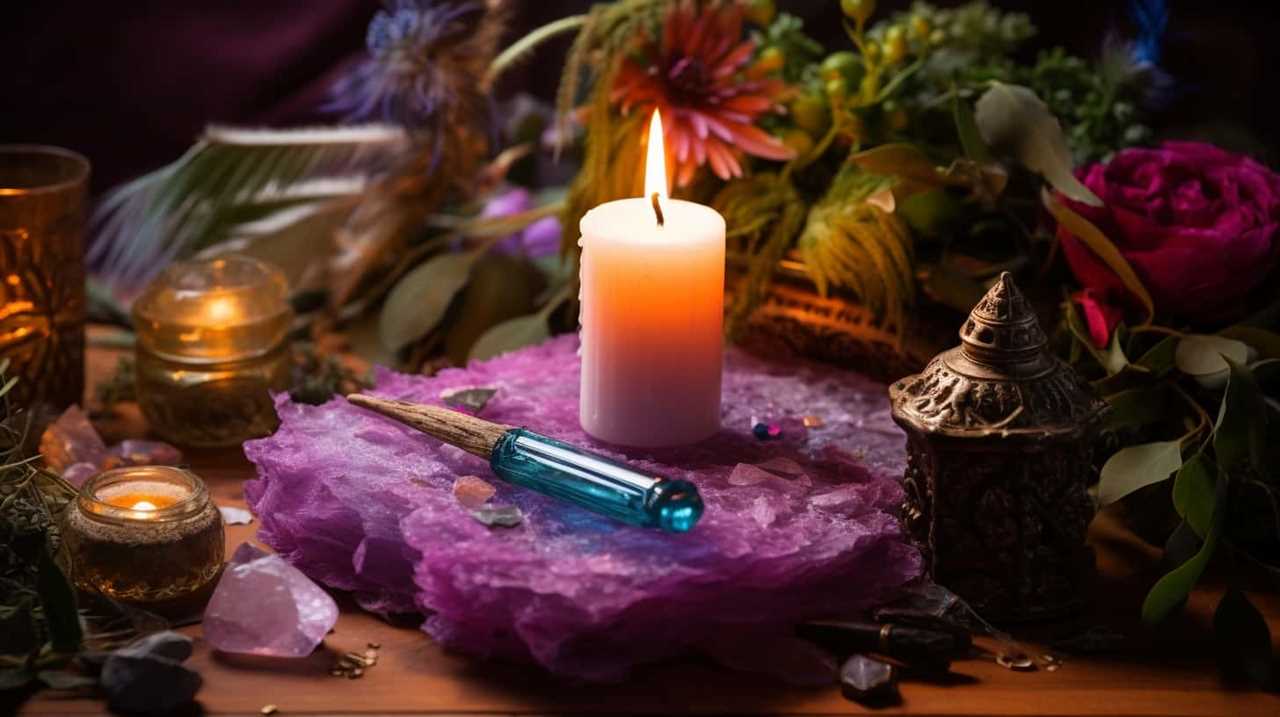
Wax Composition’s Impact
Our wax composition directly impacts the melting point of the candle wax we use for pouring. The properties of the wax composition play a crucial role in determining the melting point of the wax.
The chemical composition of the wax, including its molecular structure, chain length, and the type and amount of additives, all contribute to its melting point. For example, waxes with longer and more complex molecular structures tend to have higher melting points compared to waxes with shorter and simpler structures. Additionally, the presence of additives such as stearic acid or beeswax can increase the melting point of the wax.
Understanding the impact of wax composition on the melting point is essential for candle makers to ensure that the wax melts at the correct temperature for optimal pouring and candle quality.
Heating Methods’ Influence
To determine the optimal pouring temperature for candle wax, we need to consider the various factors that influence the melting point, including the heating methods used. The choice of heating technique can significantly impact the overall process and the quality of the final product.
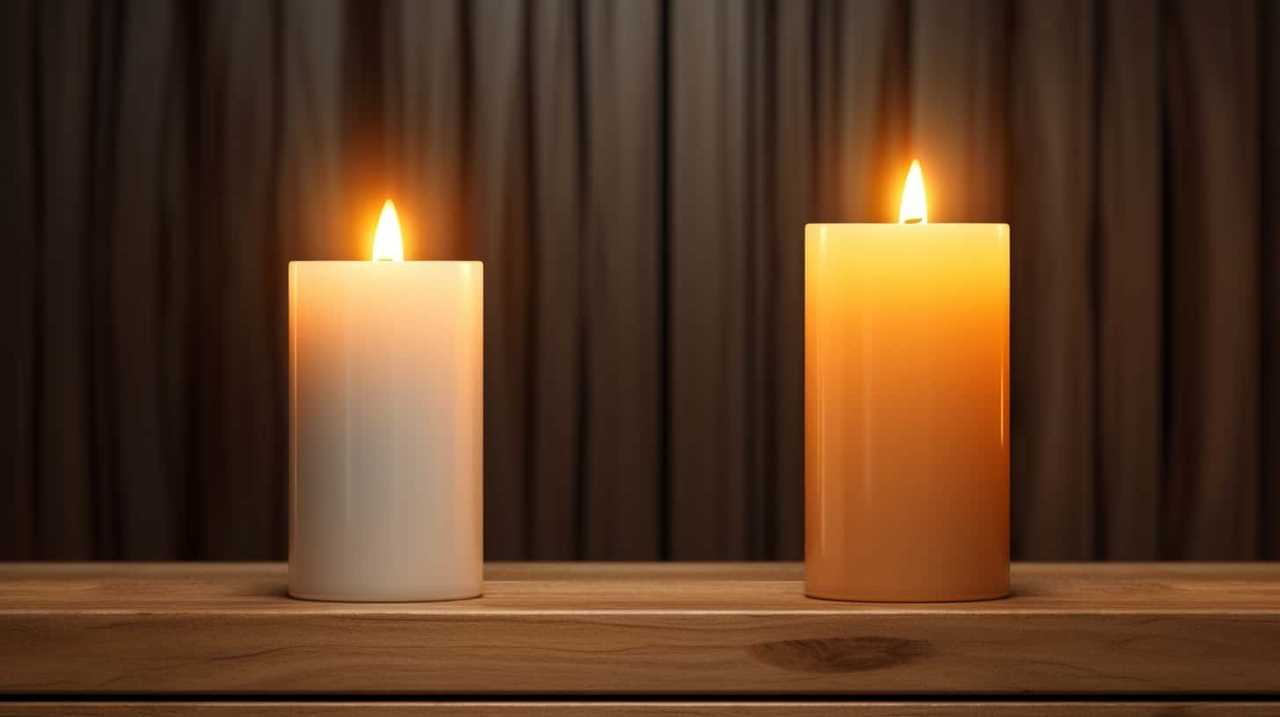
Here are three key factors to consider when it comes to heating methods and their influence on candle wax melting point:
- Direct Heat: Direct heat methods, such as using an open flame or a direct heat source like a hot plate, can provide precise temperature control. This allows for efficient and consistent heating of the wax, ensuring a uniform melting point.
- Indirect Heat: Indirect heat methods, such as using a double boiler or a water bath, provide a gentler and slower heating process. This can help prevent overheating or scorching of the wax, maintaining its integrity and desired melting point.
- Microwave Heating: Microwaving is a popular heating technique for smaller candle-making projects. However, it requires careful monitoring and frequent stirring to achieve even heating and temperature control.
Understanding the influence of heating techniques on wax melting point is crucial for achieving the desired consistency and quality of your candles.
Now, let’s explore the environmental factors that can also affect the pouring temperature.
Environmental Factors Affecting
Continuing from the previous subtopic, we can explore the environmental factors that impact the melting point of candle wax.
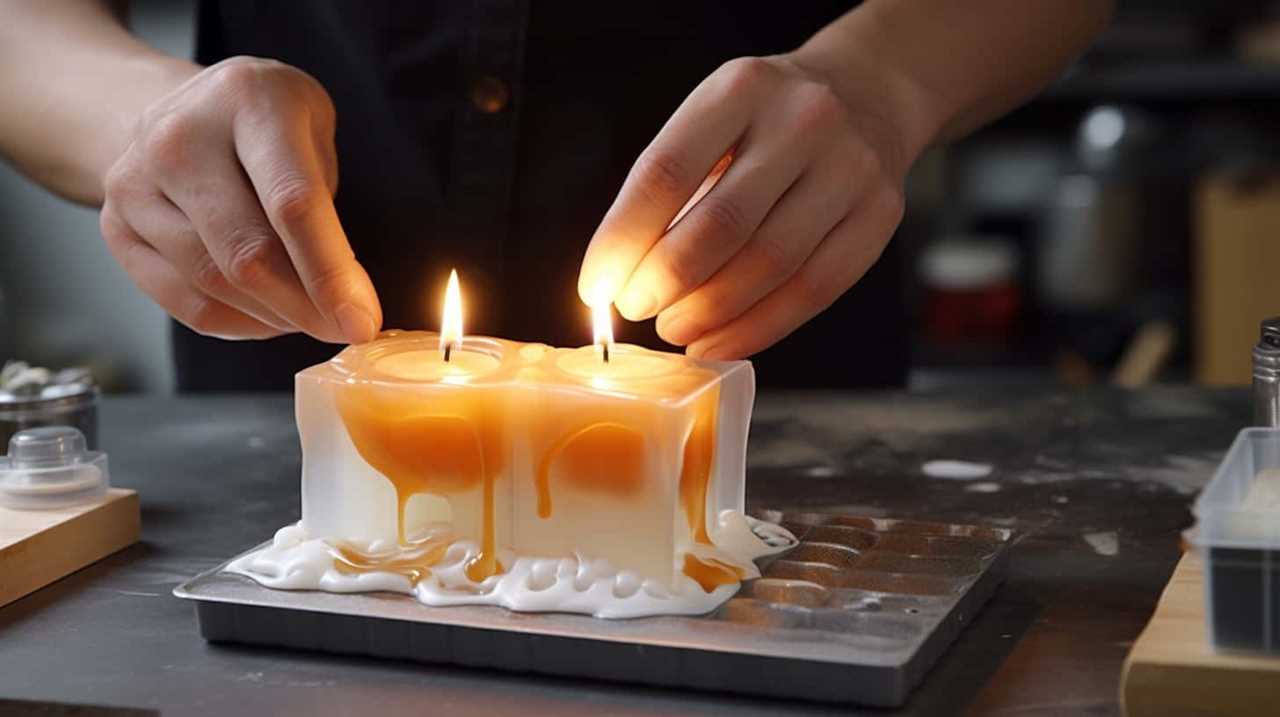
One important factor to consider is the type of heating equipment used. Different heating methods, such as a double boiler or a microwave, can affect the temperature at which the wax melts. For instance, a double boiler provides gentle and indirect heat, allowing for a more controlled melting process. On the other hand, using a microwave can result in uneven heating and potential overheating of the wax.
Another factor to consider is temperature fluctuations in the environment. Wax melting point can vary depending on the surrounding temperature. If the room is too cold, it may take longer for the wax to melt, and if the room is too hot, the wax may melt too quickly and become unstable. It’s important to maintain a consistent and appropriate temperature in the environment to ensure optimal results when pouring candle wax.
Understanding Different Wax Types
When it comes to making candles, it’s important for us to understand the different types of wax. Here are three key factors to consider:
- Heating requirements: Different waxes have varying heating requirements. Some waxes require low heat while others need higher temperatures to melt properly. Understanding the specific heating requirements of each wax type is crucial to ensure a successful pouring process.
- Melting points: Each wax type has a specific melting point, which is the temperature at which the wax changes from a solid to a liquid state. Knowing the melting point of the wax you’re using is essential for achieving the desired consistency and smoothness in your candles.
- Wax composition: Different wax types are made from various compositions, such as soy wax, beeswax, or paraffin wax. Each composition offers unique characteristics, such as scent throw, burn time, and appearance. Understanding the composition of the wax will help you choose the right type for your specific candle making project.
Finding the Right Temperature Range
When it comes to finding the right temperature range for candle wax pouring, there are several key points to consider.

First, it’s important to determine the optimal pouring temperature, as this will ensure that the wax sets properly and produces a smooth, even finish.
Additionally, it’s crucial to avoid overheating the wax, as this can lead to discoloration, fragrance loss, and other quality issues.
Optimal Pouring Temperature
To achieve the best results, we pour candle wax at the optimal temperature range. The temperature at which you pour your candle wax plays a crucial role in determining its quality and consistency. Here are three key factors to consider when finding the optimal pouring temperature:
- Wax Type: Different types of candle wax have different melting and pouring points. Understanding the specific requirements of your chosen wax type is essential for achieving consistent results.
- Fragrance and Additives: If you’re using fragrance oils or additives in your candle making process, it’s important to consider their effects on the pouring temperature. Some fragrances and additives may require specific temperature adjustments for optimal results.
- Container Material: The material of your candle container also affects the pouring temperature. Glass containers, for example, retain heat longer than metal containers, which may require a slightly higher pouring temperature.
Avoiding Wax Overheating
We recommend maintaining the wax temperature within a specific range to prevent overheating. Proper temperature control is essential in the candle-making process to ensure the quality and safety of the final product. When wax is overheated, it can lead to various issues, such as discoloration, uneven burning, and even potential fire hazards.
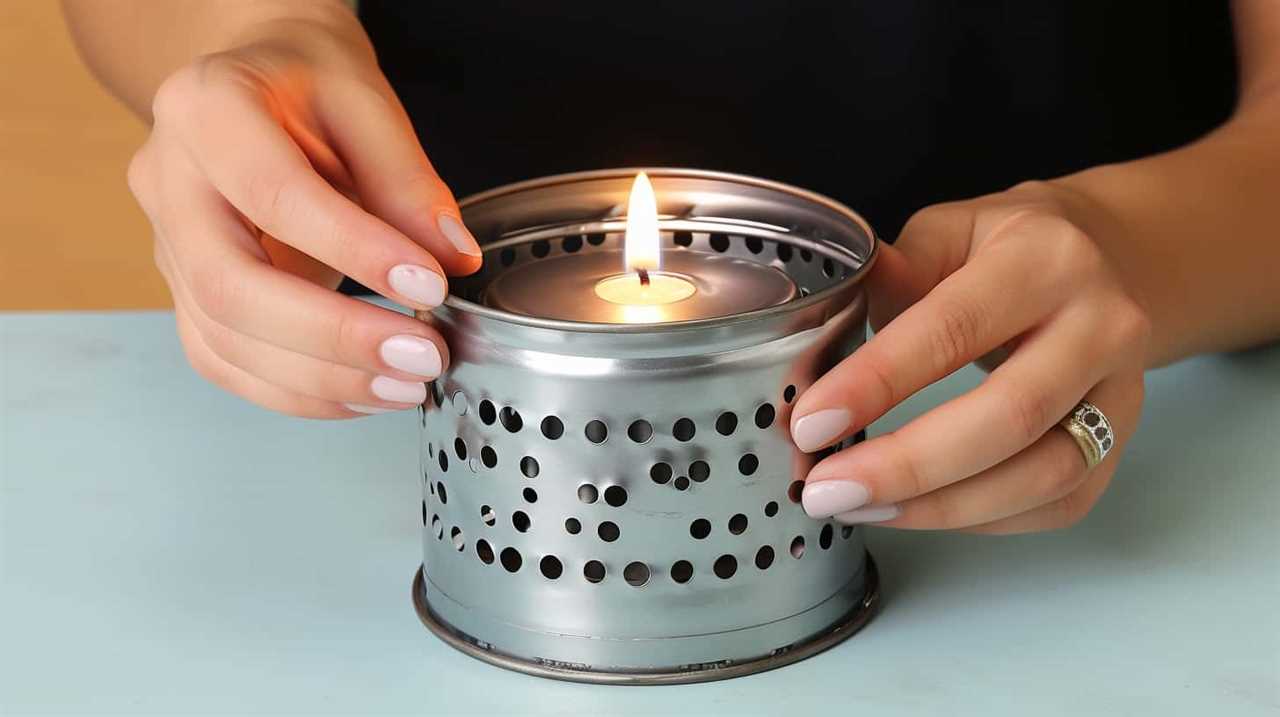
To avoid these problems, it’s crucial to monitor the wax melting temperature carefully. The ideal temperature range for melting candle wax is typically between 120°F and 180°F (49°C and 82°C). This range allows the wax to melt smoothly without reaching its flashpoint, which is the temperature at which it can ignite.
Impact on Candle Quality
Our main concern is achieving optimal candle quality by finding the right temperature range for pouring the wax. The temperature at which the wax is poured has a significant impact on fragrance distribution throughout the candle and its burning time. Here are three key factors to consider:
- Impact on fragrance distribution: Pouring the wax at the correct temperature ensures that the fragrance is evenly distributed throughout the candle. If the wax is too hot, the fragrance may evaporate or become concentrated in certain areas, resulting in an uneven scent when the candle is burned.
- Effect on burning time: The temperature at which the wax is poured can affect the burning time of the candle. If the wax is poured too hot, the candle may burn too quickly, resulting in a shorter burning time. On the other hand, if the wax is poured too cold, the candle may burn more slowly, leading to a longer burning time.
- Consistency of the candle: Pouring the wax at the right temperature helps to ensure a consistent and smooth finish. If the wax is poured too hot, it may cause the candle to develop sinkholes or uneven surfaces. Conversely, if the wax is poured too cold, it may not adhere properly to the container, resulting in an uneven and unstable candle.
Using a Thermometer for Accuracy
The use of a thermometer ensures accurate temperature measurement when pouring candle wax. Achieving the optimal temperature is crucial for producing high-quality candles. By utilizing a thermometer, you can maintain temperature precision and avoid potential issues such as improper burning, excessive smoke, and poor fragrance diffusion. A thermometer allows you to monitor the wax temperature closely and make necessary adjustments to achieve the desired pour temperature.
To illustrate the importance of thermometer accuracy, consider the following table:
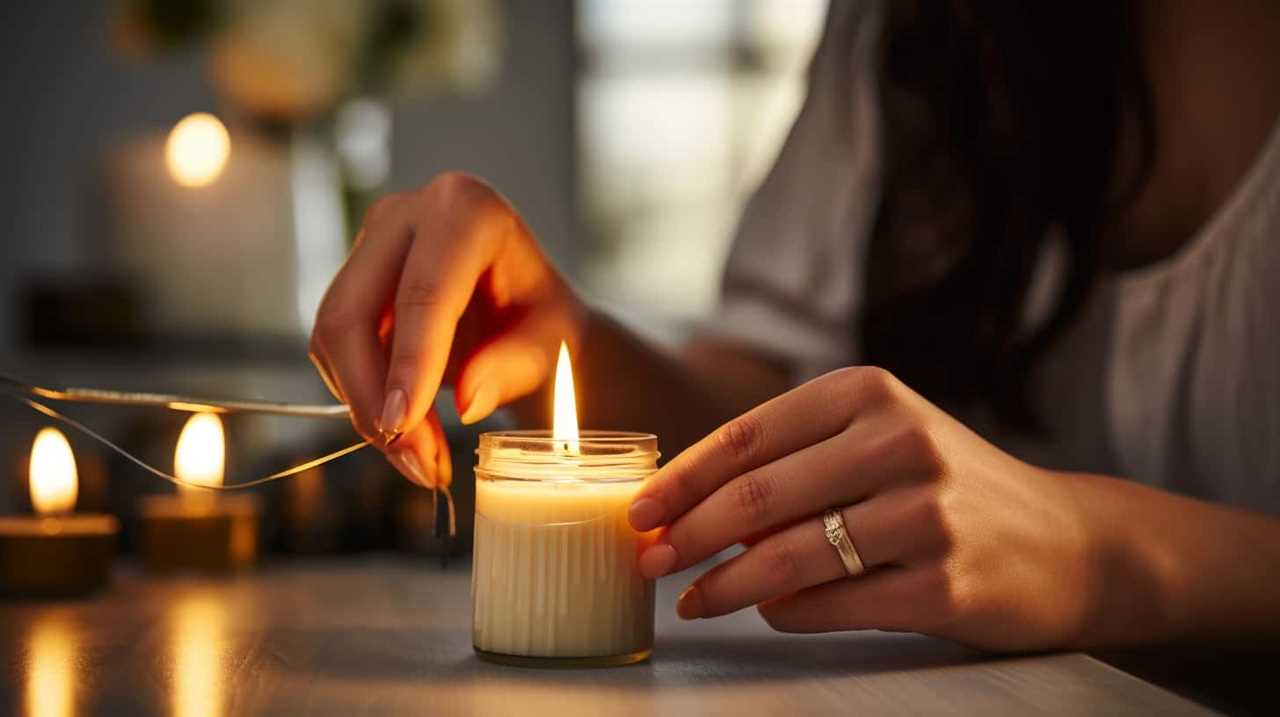
| Temperature (°F) | Candle Outcome |
|---|---|
| Below 100 | Wax won’t melt |
| 100-120 | Poor fragrance |
| 121-135 | Optimal pour |
| Above 136 | Uneven burning |
As shown in the table, maintaining the correct temperature range during the pouring process is critical for producing candles of superior quality. By relying on a thermometer, you can ensure consistency and precision in your candle-making endeavors.
Preparing Your Workspace for Pouring
Before starting the pouring process, it’s crucial to ensure the safety of your workspace. Take necessary safety precautions, such as wearing protective gloves and eyewear, to avoid any accidents.
Additionally, make sure your workspace is properly ventilated to prevent the buildup of fumes from the melting wax.
Safety Precautions for Pouring
To ensure safety during the pouring process, we frequently check and prepare our workspace. Here are some safety precautions we take:
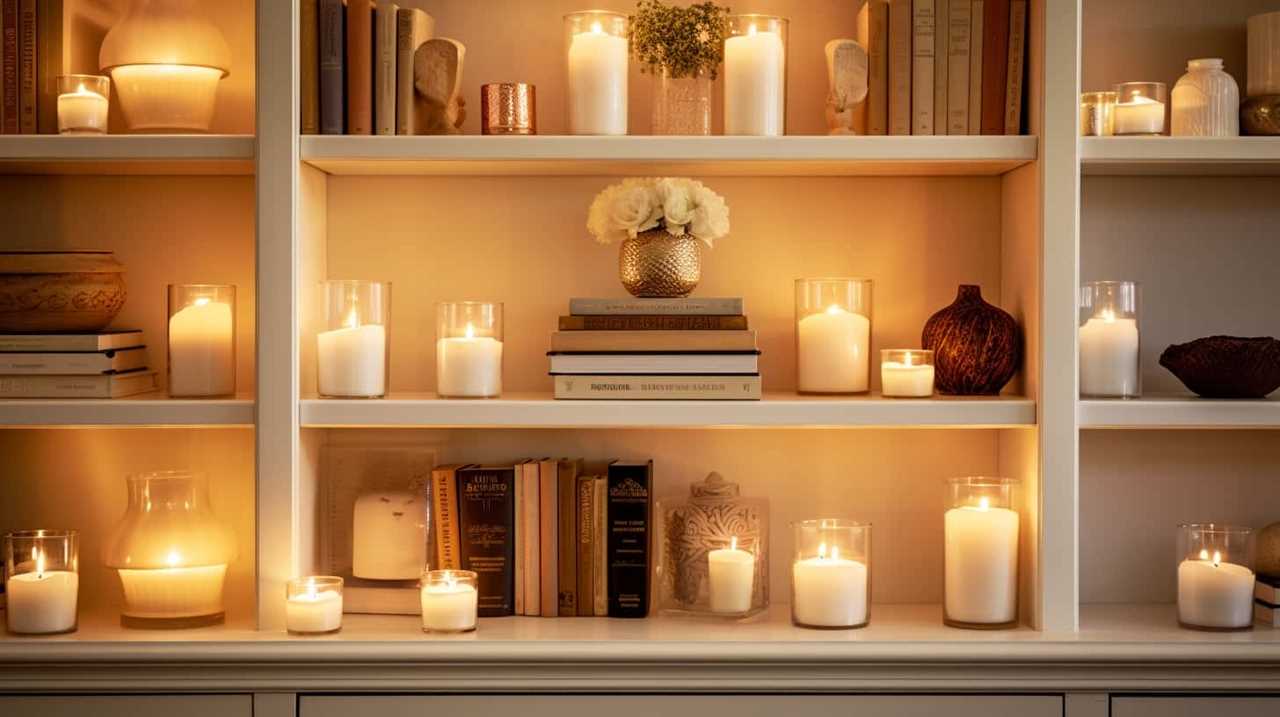
- We ensure that we’ve the proper equipment, such as heat-resistant gloves and goggles, to protect ourselves from any potential burns or splashes.
- We practice proper handling techniques by holding the containers securely and pouring the wax slowly and steadily to prevent any spills or accidents.
- We keep our workspace clean and organized to minimize the risk of tripping or knocking over containers.
By following these safety measures, we can reduce the risk of injuries and accidents during the pouring process.
Now, let’s move on to discussing the proper ventilation requirements to ensure a safe and controlled environment for candle making.
Proper Ventilation Requirements
First, we assess the ventilation needs of our workspace to ensure a safe and controlled environment for pouring candle wax. Proper ventilation is crucial in preventing the accumulation of fumes and maintaining air quality. To meet ventilation requirements, it’s recommended to work in a well-ventilated area, such as a room with open windows or a dedicated ventilation system. Adequate airflow helps to disperse any potentially harmful fumes that may be released during the pouring process. Additionally, it’s essential to remove any obstructions that may hinder the flow of air in the workspace. This includes clearing clutter and ensuring that there are no objects blocking the airflow. By preparing our workspace with proper ventilation, we can create a conducive environment for pouring candle wax safely and effectively.
Now that we’ve addressed the ventilation requirements and prepared our workspace, let’s move on to discussing the various heating methods for candle wax.
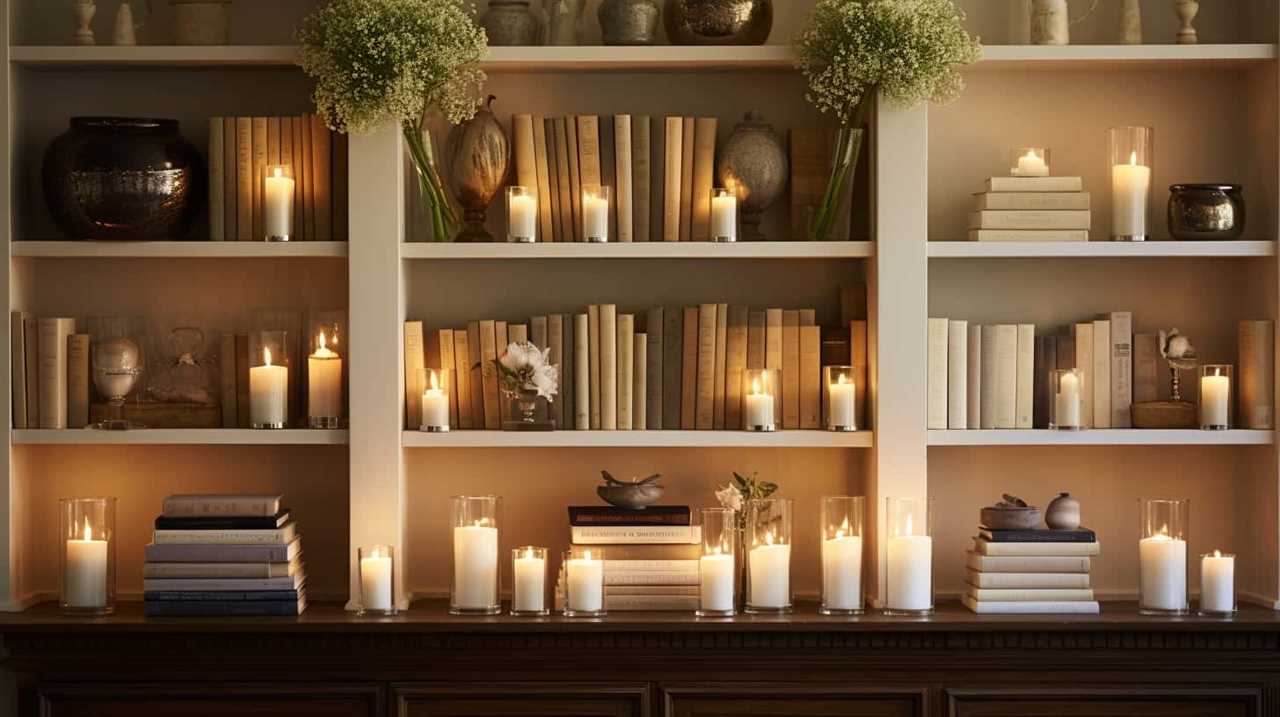
Heating Methods for Candle Wax
We typically heat candle wax using a double boiler method to ensure even and controlled melting. This method involves placing the wax in a heat-resistant container, which is then placed into a larger pot filled with water. The water is heated, and as it reaches boiling point, the wax gradually melts. This technique provides a gentle and indirect heat source, preventing the wax from overheating or burning.
To achieve optimal wax melting and temperature control, it’s crucial to follow these steps:
- Use a thermometer: Regularly monitor the wax temperature to ensure it stays within the desired range.
- Stir occasionally: Stirring the wax helps distribute heat evenly and prevents hot spots.
- Be patient: Slow and steady heating is key to prevent any sudden temperature fluctuations that could affect the quality of the wax.
By employing these heating methods, you can achieve a consistent and controlled melting process, setting the stage for perfect results.
Now, let’s delve into the subsequent section about cooling techniques for flawless outcomes.

Cooling Techniques for Perfect Results
Now let’s discuss the cooling techniques that will help us achieve perfect results in candle making.
The optimal pouring temperature is crucial for ensuring a smooth and even finish.
Additionally, the proper cooling process is essential for preventing surface imperfections such as sinkholes or cracks.
Optimal Pouring Temperature
To achieve perfect results when pouring candle wax, it’s crucial to cool the wax to the optimal temperature. The optimal pouring temperature ensures that the wax sets evenly and smoothly, resulting in a high-quality finished product.

Here are three important factors to consider when determining the optimal pouring temperature:
- Wax Type: Different types of wax have different optimal pouring temperatures. Be sure to consult the manufacturer’s guidelines for the specific wax you’re using.
- Ambient Temperature: The temperature of the room in which you’re pouring the wax can affect its cooling rate. Ensure that the room is at a consistent temperature to achieve the desired results.
- Cooling Techniques: Implementing effective cooling techniques, such as using a cooling rack or placing the molds in a cold water bath, can help speed up the cooling process and ensure the wax sets properly.
Importance of Cooling
Using the right cooling techniques is essential for achieving perfect results when pouring candle wax. Proper temperature control during the cooling process ensures that the wax solidifies evenly and avoids potential issues such as sinkholes or uneven surfaces.
One effective cooling technique is to place the freshly poured candles in a cool, draft-free area. This allows for gradual cooling, which helps prevent cracking or warping of the wax.
Another technique is to use a cooling rack or tray that allows air to circulate around the candles, promoting faster and more even cooling.

Additionally, some candle makers use techniques such as placing the candles in a refrigerator or freezer for a short amount of time to expedite the cooling process.
Experimenting with different cooling techniques can help achieve the desired results and enhance the overall quality of the finished candles.
Preventing Surface Imperfections
We use a cooling technique to prevent surface imperfections and achieve perfect results when pouring candle wax. Proper surface preparation and temperature control are crucial for minimizing imperfections and ensuring a flawless finish.
Here are three key techniques for preventing surface imperfections:
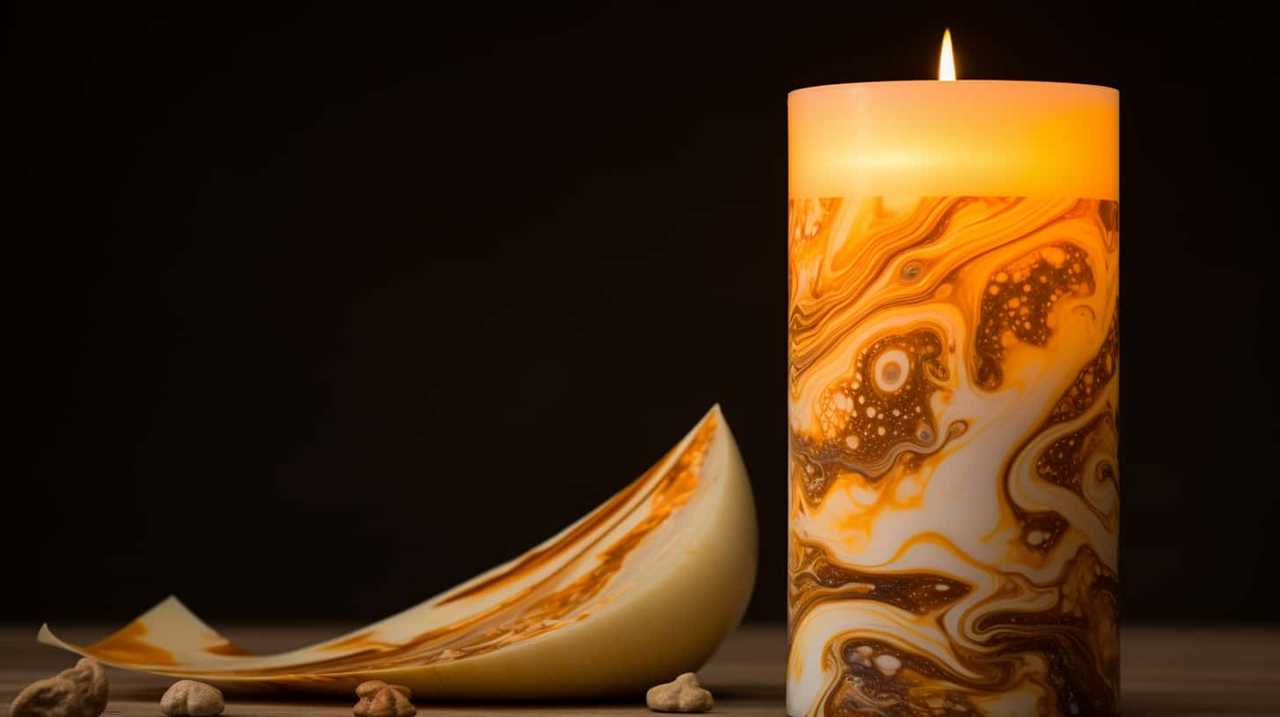
- Preheating the Mold: Before pouring the wax, preheat the mold to the desired temperature. This helps to prevent the wax from cooling too quickly and forming uneven surfaces or air pockets.
- Using a Cooling Rack: After pouring the wax, place the mold on a cooling rack. This allows air to circulate around the mold, promoting even cooling and reducing the risk of surface imperfections.
- Avoiding Sudden Temperature Changes: Rapid temperature changes can cause the wax to contract or expand unevenly, leading to cracks or blemishes. To prevent this, keep the ambient temperature stable and avoid exposing the cooling candles to drafts or extreme temperatures.
Avoiding Common Wax Temperature Mistakes
One crucial aspect in candle making is ensuring the proper temperature of the wax to prevent common mistakes. Maintaining the correct wax temperature is essential for achieving a smooth and flawless candle. Two common mistakes that can occur due to incorrect wax temperature are improper wax crystallization and inaccurate wax temperature measurement. Wax crystallization happens when the wax cools too quickly, resulting in a rough and uneven surface. To avoid this, it is important to cool the wax slowly and evenly. Additionally, accurate wax temperature measurement is crucial for achieving the desired results. Using a reliable thermometer specifically designed for candle making ensures precise temperature control. By avoiding these common wax temperature mistakes, candle makers can create high-quality candles with a professional finish.
| Common Mistakes | Causes | Prevention |
|---|---|---|
| Wax Crystallization | Wax cools too quickly | – Cool the wax slowly and evenly – Use a double boiler or a heating device – Avoid sudden temperature changes |
| Inaccurate Temperature Measurement | Using unreliable thermometers | – Invest in a reliable thermometer specifically designed for candle making – Calibrate the thermometer regularly – Follow the manufacturer’s instructions for accurate readings |
Troubleshooting Wax Temperature Issues
To troubleshoot wax temperature issues, it’s important to identify any potential factors that may be affecting the temperature of the wax during the pouring process. Here are three common troubleshooting steps to consider when encountering pouring issues and adjusting temperature settings:
- Check your thermometer: Ensure that your thermometer is accurate and calibrated correctly. An inaccurate thermometer can lead to incorrect temperature readings, resulting in pouring issues.
- Evaluate your heating method: Different heating methods, such as a double boiler or a hot plate, can have varying heat distribution. Make sure your heating method is providing even heat to avoid temperature inconsistencies.
- Assess your pouring environment: Factors like ambient temperature and drafts can influence wax cooling rates. Keep the pouring area free from drafts and maintain a consistent room temperature to ensure the wax sets properly.
Achieving Smooth and Even Pours
For achieving smooth and even pours, it’s essential to maintain the correct temperature of the candle wax. Proper temperature control is crucial to achieve consistent results and ensure a professional finish to your candles.
To achieve optimal pouring techniques, it’s important to heat the wax to the recommended temperature range. This range varies depending on the type of wax being used, but generally falls between 120°F and 180°F.
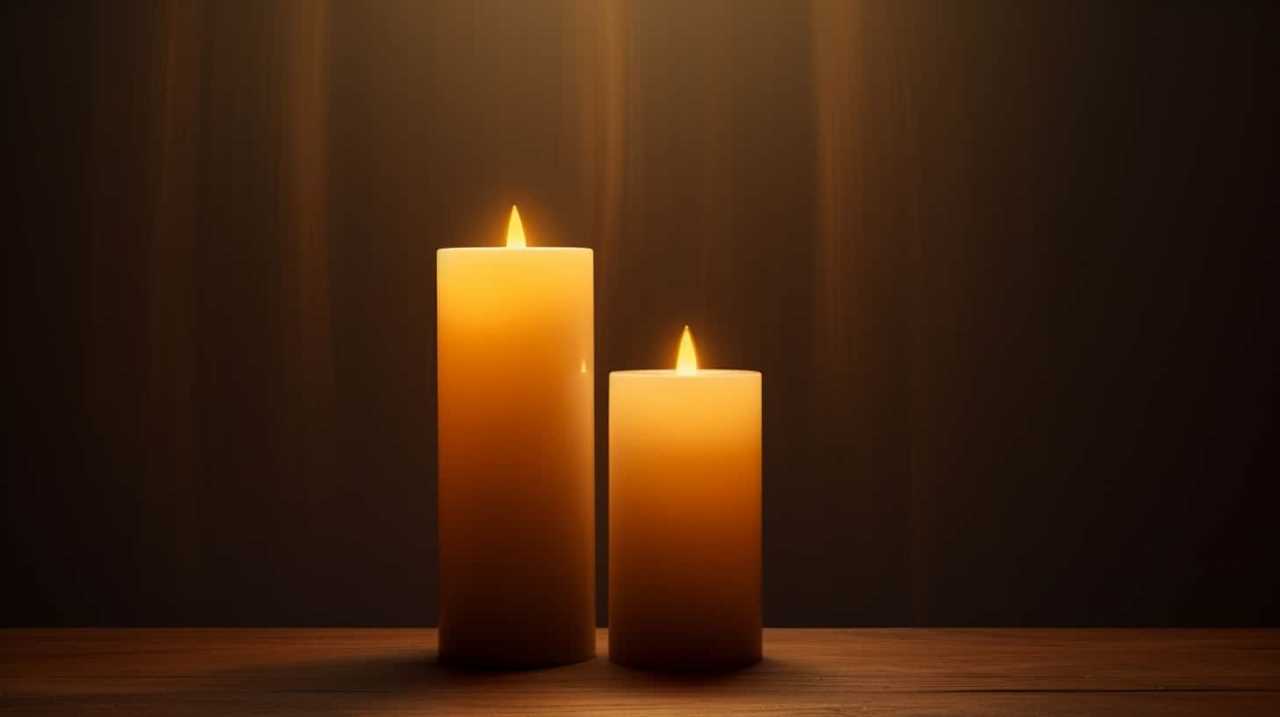
Heating the wax too high can cause it to become thin and runny, resulting in uneven pours and potential wax spills. On the other hand, if the wax isn’t heated enough, it may not fully melt and incorporate any added fragrances or dyes.
Incorporating Fragrances at the Right Temperature
To incorporate fragrances at the right temperature, we need to ensure that the wax is heated within the recommended temperature range. Fragrance compatibility and temperature control are key factors in achieving optimal results. Here are three important points to consider:
- Fragrance Compatibility: Different fragrances have different flashpoints, which is the temperature at which they release their scent. It’s crucial to choose fragrances that are compatible with the wax you’re using. This ensures that the fragrance is evenly distributed throughout the candle and doesn’t separate or lose its potency during the pouring process.
- Temperature Control: Maintaining a consistent temperature throughout the fragrance incorporation process is essential. Too high a temperature can cause the fragrance to dissipate or burn off, while too low a temperature may result in poor fragrance dispersion. Using a reliable thermometer and monitoring the temperature closely will help you achieve the desired fragrance infusion.
- Testing and Experimentation: It’s always advisable to conduct small-scale tests and experiments before incorporating fragrances into larger batches. This allows you to assess the fragrance’s performance and make any necessary adjustments to the temperature or fragrance concentration.
Coloring Wax at the Optimal Heat Level
We recommend using a small amount of dye at the optimal heat level to achieve the desired color for your candle wax. Coloring techniques play a crucial role in creating visually appealing candles.
Temperature control is essential when incorporating dyes into the wax. Maintaining the ideal heat level allows for better dispersion and integration of the color. It’s important to note that different dyes have specific temperature requirements for optimal results. Some dyes may require higher temperatures to dissolve completely, while others may require lower temperatures to avoid discoloration.

It’s recommended to follow the instructions provided by the dye manufacturer to ensure accurate coloring.
By controlling the temperature during the coloring process, you can achieve consistent and vibrant colors in your candle wax.
Now, let’s move on to discussing pouring techniques for different candle styles.
Pouring Techniques for Different Candle Styles
To ensure the best results, it’s important to understand the appropriate pouring techniques for different candle styles. Here are three key techniques to consider:
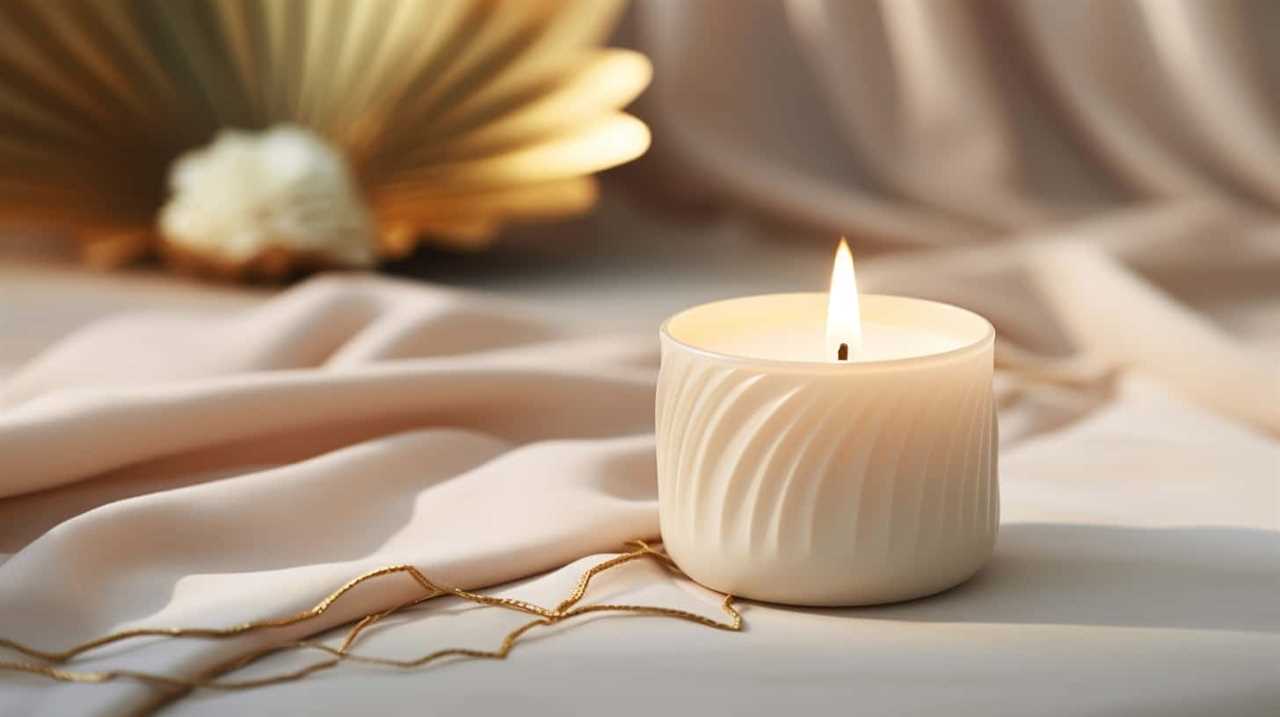
- Single Pour Technique: This technique involves heating the wax to the recommended temperature and pouring it directly into the final container. It’s commonly used for container candles as it eliminates the need for a second pour.
- Layered Pour Technique: Suitable for creating multi-colored or scented candles, this technique involves pouring layers of wax at different temperatures. Each layer is poured once the previous one has solidified.
- Marbling Technique: This technique creates a unique marbled effect. It involves pouring different colored waxes into the pouring container simultaneously. The waxes are then gently swirled together before pouring into the final container.
Remember to choose pouring containers that are heat-resistant and have a pouring spout for precision. Mastering these pouring techniques will help you create beautiful candles with professional results.
Experimenting With Wax Temperature for Unique Effects
As we delve into the subtopic of ‘Experimenting With Wax Temperature for Unique Effects’, it’s important to explore how varying the temperature can create distinct and captivating results. When experimenting with wax temperature, we’ve the opportunity to achieve unique effects that can enhance the overall aesthetic appeal of our candles.
By adjusting the temperature at which we pour the wax, we can manipulate its viscosity and consistency, resulting in different textures and patterns. For instance, pouring wax at a higher temperature can create a smoother and more even surface, while pouring at a lower temperature can produce a textured and rustic appearance.
Additionally, varying the temperature can also affect the rate at which the wax cools and solidifies, influencing the formation of cracks, bubbles, or other visually interesting elements.
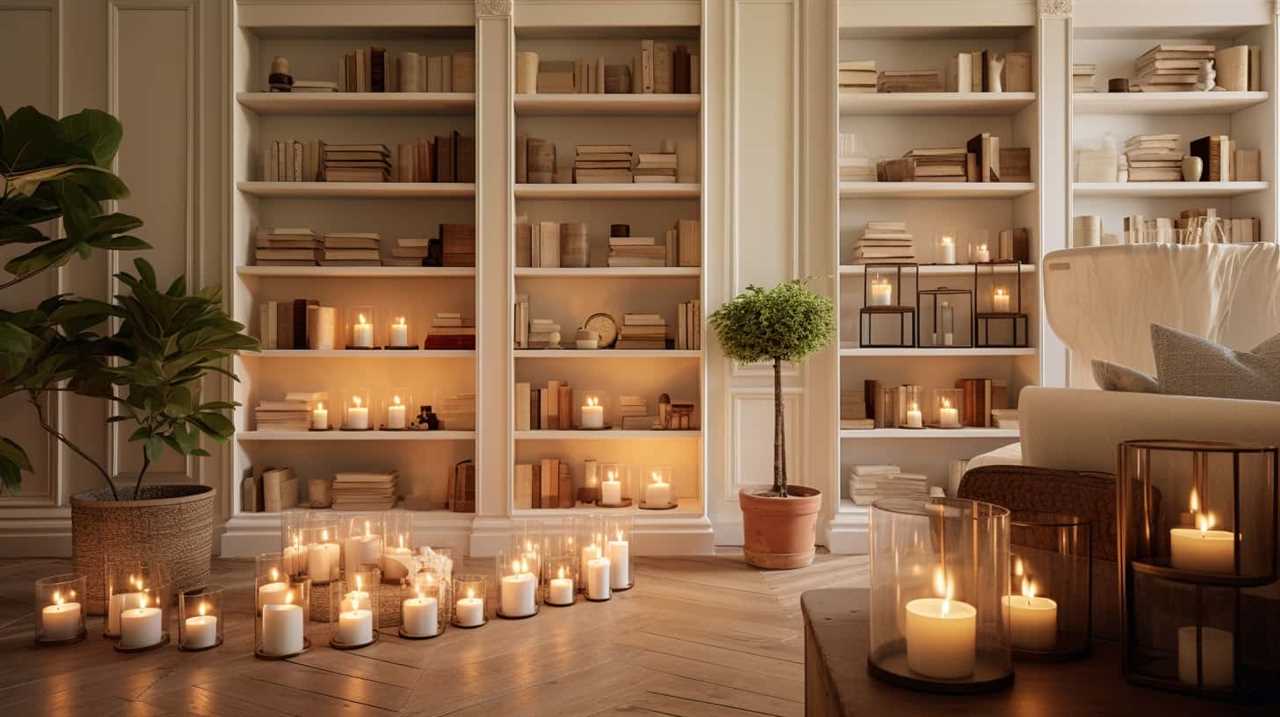
Through careful experimentation, we can unlock endless possibilities for creating candles with truly unique effects.
Frequently Asked Questions
How Do I Choose the Right Wax for My Candles?
When choosing wax for our candles, we consider factors such as burn time, scent throw, and appearance. We also explore different candle fragrance options to create a unique and enticing product.
Can I Use a Regular Kitchen Thermometer to Measure the Wax Temperature?
We can measure wax temperature accurately using alternative tools such as a digital candy thermometer or an infrared thermometer. Regular kitchen thermometers may not provide accurate readings due to their limited temperature range.
What Safety Precautions Should I Take When Working With Hot Wax?
To ensure our safety, we must take proper precautions when working with hot wax. This includes wearing protective gear like gloves and goggles, ensuring a well-ventilated area, and having a fire extinguisher nearby.
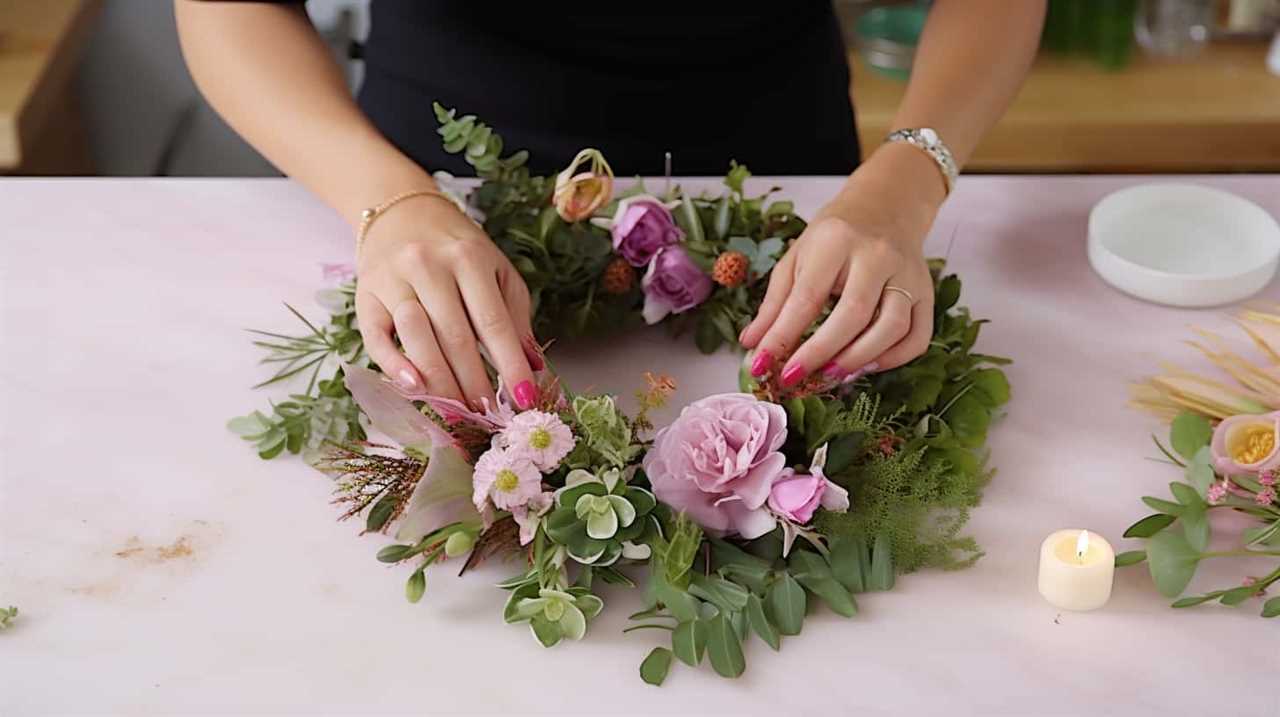
Can I Reheat Cooled Wax to Adjust Its Temperature?
Yes, you can reheat cooled wax to adjust its temperature. This allows for precise control when pouring candles. However, it’s important to monitor the temperature closely to avoid overheating, which can affect the quality of the wax.
How Long Does It Take for the Wax to Cool and Solidify After Pouring?
The cooling time of candle wax depends on various factors such as the type of wax used and the ambient temperature. However, pouring the wax at the recommended temperature ensures optimal solidification time.
Conclusion
In conclusion, achieving the right temperature for pouring candle wax is crucial for successful candle making.
Factors such as wax type, fragrance incorporation, and coloring all play a role in determining the optimal heat level.
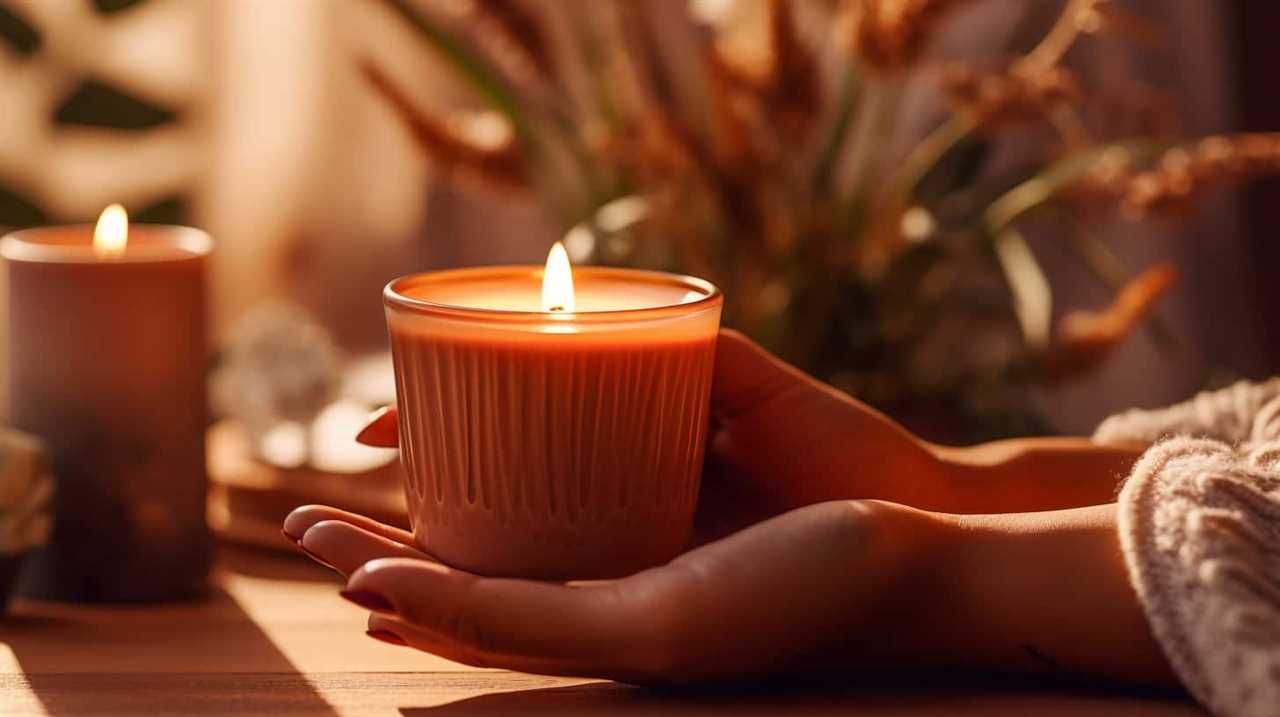
By using a thermometer for accuracy and experimenting with different temperatures, one can create unique effects and enhance the overall candle-making experience.
So let your creativity soar and watch your candles come to life with the perfect wax temperature, like a symphony of colors melting together in harmony.

